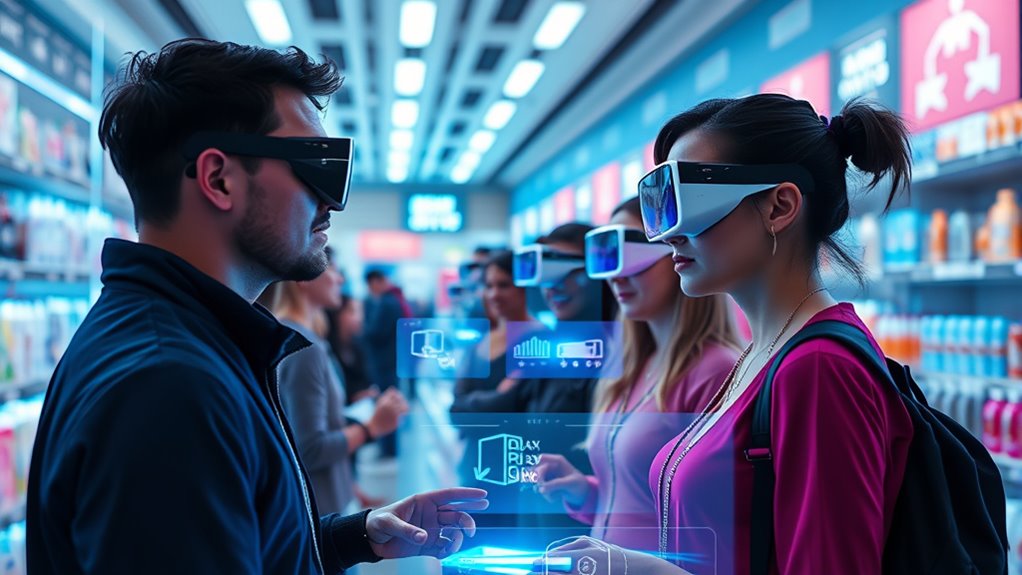In 2025, you’ll see digital marketing become increasingly personalized thanks to AI-driven insights, automation, and predictive analytics. Immersive tech like VR and AR will transform how you engage consumers, creating memorable experiences. Privacy and ethics will be crucial, so transparent data practices are essential. Voice and visual search will grow, alongside seamless omnichannel strategies. Staying ahead means mastering these trends—continue exploring to discover how you can leverage them effectively.
Key Takeaways
- AI-driven personalization and automation will deliver hyper-targeted, real-time customer experiences across multiple channels.
- Immersive technologies like VR and AR will revolutionize product engagement and experiential marketing strategies.
- Ethical data practices and privacy compliance remain critical as consumers demand transparency and security.
- Voice and visual search optimization will become essential for capturing emerging search behaviors.
- Omnichannel integration will enhance seamless customer journeys, blending digital and physical touchpoints effectively.
The Rise of AI-Driven Personalization and Automation

As AI technology continues to advance, it’s transforming how businesses deliver personalized experiences and automate marketing tasks. You now have access to vast amounts of consumer data, which fuels sophisticated personalization algorithms. These algorithms analyze browsing habits, purchase history, and engagement patterns to craft tailored content and offers. By harnessing AI-driven insights, you can deliver relevant messages at the right moment, increasing engagement and conversions. Automation streamlines tedious tasks like email campaigns, ad targeting, and content recommendations, freeing you to focus on strategic growth. The combination of consumer data and advanced algorithms enables highly precise personalization, making your marketing efforts more effective. Additionally, automated content creation is emerging as a powerful tool to generate customized marketing materials at scale, further enhancing personalization capabilities. This synergy between technology and data ensures that your marketing remains customer-centric and competitive in a rapidly evolving landscape. Incorporating meditation techniques into your strategic planning can help maintain focus and foster innovative ideas, ensuring your approach stays adaptable. Understanding the importance of content optimization can significantly improve your campaign performance. Furthermore, staying updated on industry trends can help you anticipate market shifts and adapt your strategies proactively. The result is a more responsive and customer-centric brand, driving loyalty in an increasingly competitive landscape.
Immersive Technologies Transforming Consumer Engagement

Immersive technologies like virtual reality and augmented reality are changing how you interact with brands, offering more engaging experiences. You can now explore products virtually or try on items using AR, making shopping more interactive and personalized. As content creation becomes more immersive, brands have new ways to captivate your attention and foster deeper connections. Incorporating high-resolution projectors into retail environments can further enhance these immersive experiences by providing sharp, vibrant visuals that draw customers in. Additionally, advancements in sound design and trailer music techniques can amplify emotional engagement, creating more memorable interactions. The integration of safety features in equipment also ensures these innovative displays are both exciting and secure for consumers and staff alike. Incorporating sustainable packaging and eco-friendly materials also plays a role in aligning brand experiences with consumer values. Moreover, the use of advanced display technology can elevate the visual appeal of immersive displays, making experiences more captivating.
Virtual Reality Experiences
Virtual reality experiences are rapidly transforming how consumers engage with brands by offering immersive, interactive environments that captivate attention and foster deeper connections. With virtual reality, you can transport your audience to a different world, creating powerful moments of consumer immersion. This technology allows you to showcase products in a realistic setting, enabling users to explore and interact as if they were physically present. As a result, engagement becomes more meaningful and memorable. Virtual reality also provides personalized experiences tailored to individual preferences, increasing the likelihood of conversion. By incorporating virtual reality into your marketing strategy, you stand out in a crowded digital landscape, building stronger emotional bonds and enhancing brand loyalty through truly immersive interactions. Incorporating interactive features can further elevate these experiences, making them even more engaging and memorable. Additionally, leveraging immersive technologies can help brands gather valuable insights into consumer preferences and behaviors, optimizing marketing efforts. For example, integrating AI-driven personalization can customize experiences in real-time, further boosting engagement and effectiveness. Furthermore, understanding the supernatural realm can inspire innovative storytelling techniques that resonate on a deeper emotional level, enhancing the overall immersive experience.
Augmented Reality Shopping
Augmented reality shopping is revolutionizing how you interact with brands by blending digital elements with the real world to create seamless, engaging experiences. You can now use virtual try-ons to see how products look on you before purchasing, reducing uncertainty and increasing confidence. Interactive product displays allow you to explore items in detail, from all angles, right from your device. This immersive approach not only enhances customer engagement but also shortens the purchase journey. Moreover, these technologies are driving consumer engagement to new heights by offering personalized and memorable shopping experiences. Additionally, the integration with e-commerce platforms enhances targeted marketing and seamless checkout processes, making the experience even more compelling. The use of humorous and thought-provoking dog quotes in describing these technologies helps convey their innovative and transformative nature to consumers. As these immersive solutions become more prevalent, they are fostering a deeper sense of brand loyalty among shoppers, encouraging repeat engagement and trust.
Immersive Content Creation
As technology advances, brands are increasingly leveraging immersive content creation to captivate audiences and deepen engagement. You can craft experiences through interactive storytelling that invites users to participate actively, making your brand memorable. Sensory branding plays a vital role by appealing to sight, sound, touch, and even smell, creating a multi-sensory environment that immerses your audience. With immersive technologies like virtual reality and 3D environments, you can transport consumers into your brand universe, fostering emotional connections. These experiences not only boost engagement but also encourage sharing and word-of-mouth promotion. Additionally, understanding the safety of electronic devices like heated mattress pads ensures that brands promote products responsibly in their immersive demonstrations. Proper gear shifting techniques and equipment maintenance can also be integrated into virtual training modules to enhance user knowledge and confidence. Incorporating mindful decluttering principles into content design helps create more streamlined and focused experiences, reducing cognitive overload for users. Recognizing the importance of software development lifecycle knowledge allows brands to tailor virtual experiences that resonate with adventure-seeking audiences, further strengthening brand affinity. By integrating immersive content, you make your marketing efforts more dynamic, personalized, and impactful—ensuring your brand stands out in an increasingly crowded digital landscape.
Data Privacy and Ethical Marketing Practices

With increasing awareness about data security, consumers now expect companies to prioritize their privacy and handle personal information responsibly. You need to be transparent about how you collect, store, and use consumer data, building trust through honest communication. Implementing transparent policies and adhering to privacy regulations like GDPR and CCPA isn’t optional; it’s indispensable to demonstrate your commitment to ethical marketing practices. Respecting consumer data means implementing robust security measures and giving users control over their information. Failure to do so risks damaging your reputation and facing legal penalties. As privacy concerns grow, integrating ethical principles into your marketing strategies becomes crucial. By doing so, you not only protect your customers but also create a competitive edge in a landscape where trust is paramount. Incorporating data security practices is essential for maintaining consumer confidence and compliance.
The Expansion of Voice and Visual Search

As voice and visual search become more prevalent, optimizing for voice search helps you reach users who speak naturally and use smart devices. Engaging visual content captures attention quickly and encourages users to interact with your brand. Staying ahead means focusing on both voice search optimization and compelling visual content strategies.
Voice Search Optimization
The rise of voice and visual search is transforming how consumers find information online, making it essential for digital marketers to optimize accordingly. Voice search, powered by advanced speech recognition, is changing search behavior, requiring you to adapt your content. To stay ahead, consider these strategies:
- Use natural language keywords that match conversational queries.
- Focus on long-tail keywords and question-based phrases.
- Optimize local SEO, as many voice searches are location-specific.
Visual Content Engagement
Advancements in voice search are coinciding with a surge in visual search technologies, reshaping how you discover and engage with content online. Visual content now plays a pivotal role in capturing attention and delivering information quickly. Interactive infographics enable you to explore data dynamically, enhancing your understanding and retention. Visual storytelling allows brands to craft compelling narratives that resonate emotionally, making content more memorable. As visual search becomes more sophisticated, optimizing images and videos for discovery is essential. Incorporate rich, descriptive metadata and high-quality visuals to improve visibility. By leveraging these tools, you can create engaging, shareable content that meets your audience’s evolving expectations and drives deeper interaction. Staying ahead means embracing innovative visual strategies that enhance your digital marketing efforts.
The Growth of Omnichannel Marketing Strategies

With consumers increasingly expecting seamless experiences across all touchpoints, businesses are rapidly expanding their omnichannel marketing strategies. You need to focus on creating a unified customer journey that feels natural, no matter the channel. Effective channel integration allows your audience to move effortlessly between online and offline interactions. To succeed, consider these key points:
- Deliver consistent messaging across platforms to strengthen brand recognition.
- Use data-driven insights to personalize experiences at every touchpoint.
- Optimize each channel for mobile, social, and in-store engagement.
Advanced Customer Journey Mapping With AI

As artificial intelligence continues to evolve, it’s transforming how businesses map and understand customer journeys. Predictive analytics now enable you to anticipate customer behaviors and preferences with greater accuracy, allowing for more personalized interactions. AI-driven customer journey mapping combines data from multiple touchpoints, revealing patterns and points of friction you might miss otherwise. With advanced customer segmentation, you can tailor marketing efforts to specific groups, boosting engagement and conversion rates. These tools enable you to visualize the entire customer experience in real-time, making it easier to optimize touchpoints proactively. As a result, you gain deeper insights into your audience, improve targeting, and create seamless, meaningful experiences that drive loyalty and growth.
Sustainability and Purpose-Driven Branding

Have you noticed how consumers are increasingly seeking brands that stand for more than just products? They want purpose-driven marketing and authentic sustainable branding that align with their values. To meet this demand, you should focus on transparency, social impact, and environmental responsibility. Highlight your sustainability initiatives and communicate your brand’s purpose clearly across channels. Consumers are quick to support brands that demonstrate genuine commitment to positive change, making purpose-driven branding a powerful differentiator.
- Showcase your sustainable practices authentically
- Share stories that emphasize your brand’s mission
- Engage with communities focused on social and environmental issues
The Integration of 5G and Edge Computing in Marketing

The rapid rollout of 5G and edge computing is transforming marketing strategies by enabling real-time data processing and instant customer interactions. With 5G integration, you can deliver seamless, high-speed experiences that meet customer expectations for immediacy. Edge computing allows data to be processed closer to the user, reducing latency and improving personalization. This means your marketing campaigns can leverage real-time insights to adapt on the fly, optimizing engagement and conversions. You’ll be able to offer ultra-responsive services, such as AR/VR experiences or dynamic content updates, directly on users’ devices. As 5G and edge computing become more widespread, your ability to deliver highly targeted, immediate experiences will become a key differentiator, making your marketing more efficient, engaging, and competitive in 2025.
Frequently Asked Questions
How Will AI Influence Future Marketing Job Roles and Skills?
AI automation and predictive analytics will reshape your marketing roles by making data-driven decisions faster and more accurate. You’ll need to develop skills in managing AI tools, interpreting analytics, and creating personalized campaigns. As AI handles routine tasks, your focus shifts to strategic thinking and creative problem-solving. Staying adaptable and continuously learning new technologies will be essential to thrive in the evolving marketing landscape driven by AI advancements.
What Are the Emerging Ethical Considerations in Immersive Marketing?
You should be aware of emerging ethical considerations in immersive marketing, especially around privacy concerns and consent management. As you create more engaging experiences, guarantee you respect user privacy by clearly communicating data collection practices. Obtain explicit consent and provide easy options to opt out. Balancing innovative immersive content with these ethical standards helps build trust with your audience and avoids potential legal or reputational risks.
How Can Brands Effectively Measure Success Across Multiple Channels?
To effectively measure success across multiple channels, you should leverage multichannel analytics and cross-platform metrics. Track how your audience interacts across different touchpoints, analyzing engagement, conversions, and ROI. Use unified dashboards to gather data from social media, email, website, and other channels. This approach helps you identify what’s working, optimize your strategies, and guarantee consistent brand messaging, ultimately boosting your overall marketing performance.
What Are the Best Practices for Integrating Sustainability Into Marketing Strategies?
You should prioritize sustainable branding by clearly communicating your eco-friendly initiatives and values. Incorporate eco-friendly campaigns that highlight your commitment to sustainability, making them authentic and transparent. Use storytelling to connect emotionally with your audience, emphasizing your environmental efforts. Consistently showcase eco-conscious practices across all channels, involve your community, and measure impact. This approach boosts brand loyalty and aligns your marketing with consumers’ growing demand for sustainability.
How Will 5G Impact Real-Time Customer Data Collection and Analysis?
You’ll see 5G acceleration revolutionize real-time customer data collection and analysis by enabling faster, more reliable connections. This boosts data precision, allowing you to gather richer insights instantly. With improved connectivity, you’ll track customer behaviors more accurately, personalize experiences, and respond swiftly to trends. The enhanced data flow empowers smarter marketing strategies, helping you stay ahead in a competitive landscape and deliver targeted, timely content that truly resonates.
Conclusion
By 2025, over 80% of marketers plan to prioritize AI-driven personalization and immersive tech, transforming how you engage customers. Staying ahead means embracing these trends, respecting data privacy, and leveraging new channels like voice search. If you adapt now, you’ll be better positioned to boost loyalty and conversions. The future of digital marketing is exciting—are you ready to lead with innovation and purpose?









